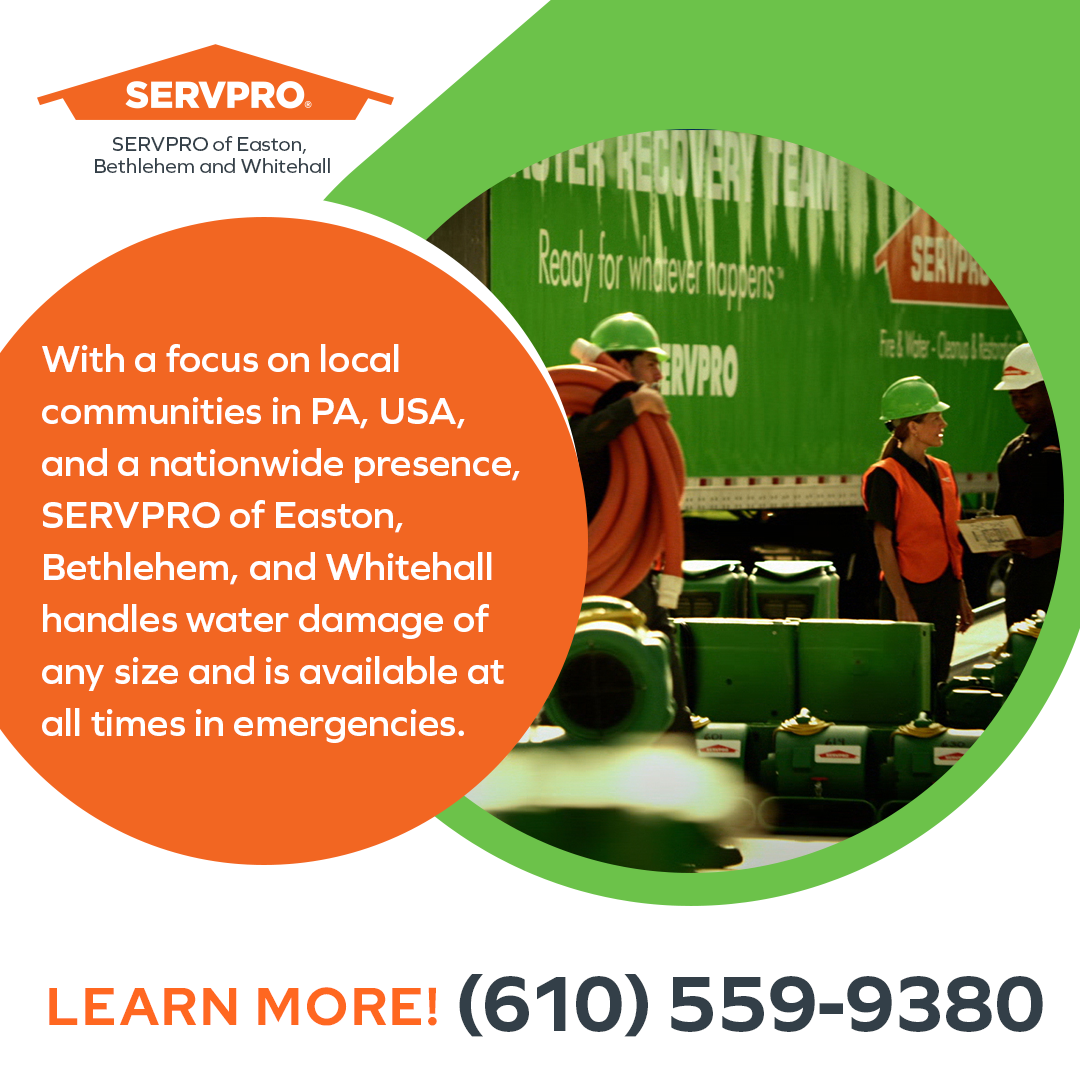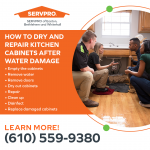The kitchen has always been an important part of a home. It is referred to as the heart of the home sometimes. Even today it is where families gather together, cook and share meals, and spend time together. Even after the pandemic kitchens have become more important as they are also used as workstations and study nooks. This is why kitchen design is very important and homeowners always try to maintain a neat and bright kitchen.
Kitchens are at risk of water damage as chances of faulty plumbing, leaky sinks, and malfunctioning appliances can expose the kitchen to water. Though the kitchen is designed and constructed to prevent water damage as far as possible, this can always happen. In case of water damage in the kitchen or anywhere else, SERVPRO of Easton, Bethlehem, and Whitehall is a water damage restoration company that communities across Pennsylvania can turn to. In this article, the water damage restoration company gives some information on the causes of water damage in the kitchen and how it can be repaired.

Causes of Water Damage In The Kitchen
- Water can spill in many instances in a kitchen, and it can be of different temperatures. Splashes of water can flow and if left for long moisture can lead to water damage.
- Kitchen appliances like refrigerators or dishwashers can malfunction and leak.
- Kitchen sink faucets can be leaky with wear and tear.
- Pipes can burst when frozen or when old. There can be small leaks that are not visible easily.
How To Dry and Repair Kitchen Cabinets After Water Damage
Once there is water damage in a kitchen cabinet the following steps can be taken.
1. Empty The Cabinets
The cabinets that have been exposed to water must be emptied. Paper goods, dish towels, and other fabrics may need to be discarded depending on the type of water damage. All food stored in boxes or bags may need to be discarded as moisture might be present in the. Glass or plastic containers that are airtight and watertight might be safe.
2. Removing Water
As much of the water in the cabinet must be removed as soon as possible. If water is left for long, the extent of water damage will be worse. After wiping the cabinets down with thick towels, they can be dried with kitchen towels till the cabinets feel dry to the touch.
3. Remove Doors
Removing cabinet doors speeds up drying and limits the water damage. Sagging and crumbling of particle board can happen due to the weight of the cabinet door. If the doors are removed they can be kept flat to prevent warping. High-volume fans can help to dry them faster.
4. Drying Out Cabinets
Once the doors are removed the kitchen cabinets can be dried. Unless the water damage is very minimal, household fans may not be efficient enough to dry the cabinets. High-volume fans and structural drying dehumidifiers get the job done. This equipment can be rented. Alternatively, a water damage restoration expert can be contacted for water damage repair. Such companies have all the specialized equipment to deal with water damage safely and efficiently. The fans may need to be repositioned periodically to cover all areas including behind and underneath the kitchen cabinets.
5. Repair
Kitchen cabinets might be repaired depending on the extent of water damage. Delaminated layers of the cabinet may be fixed with carpenter's glue and clamps.
6. Cleaning up
When cabinets are repaired after water damage, they might have water stains. Cabinets will have to be cleaned. They can be sanded down for a neat appearance. A sealant and a stain coat followed by a top coat to protect the wood will help make the kitchen cabinets look good.
7. Disinfection
After drying, cabinets may need to be disinfected. Homeowners who prefer DIY methods may use a bleach solution to remove bacteria, mold, and odors. Keeping the kitchen windows open to promote ventilation can help eliminate odor. Water damage restoration professionals will have specialized equipment and supplies to clean and disinfect the area after water damage.
8. Replacing Damaged Cabinets
Once kitchen cabinets show signs of crumbling after water damage. Especially if the cabinet is made of particle board, it is damaged after exposure to water. Beyond a certain extent of water damage, cabinets may not be usable. They will have to be discarded and replaced.
Flooding or leaking in the kitchen can turn cabinets into a soggy mess. Cabinets are made of wood, MDF, or particle wood. When particleboard gets wet, it absorbs water and can swell up. The glue that holds the cabinet dissolves when water comes in contact for a long time. The longer the kitchen cabinet is exposed to water, the faster it gets damaged. When there is prolonged exposure to moisture the risk of mold or rot is more. This is why water damage must be handled in a time-sensitive manner. Unless the water damage is minimal, the safer option is to hire a water damage restoration company to get things back to a pre-damage condition.

SERVPRO of Easton, Bethlehem, and Whitehall is a damage restoration company offering fire and water damage restoration services for residential and commercial property owners. With a focus on local communities in PA, USA, and a nationwide presence, this water damage restoration company handles water damage of any size and is available at all times in emergencies. For any water damage restoration needs they can be contacted by email at servpro5770@servproofeaston.com or by dialing the number (610) 559-9380.
































